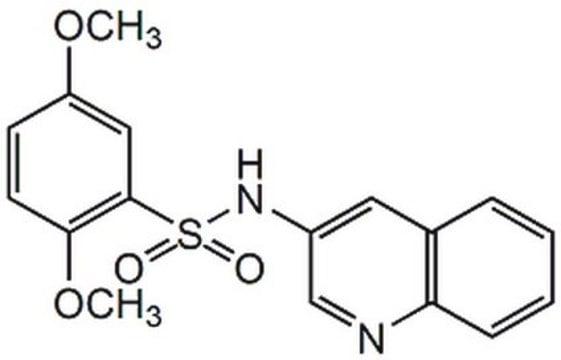E114
EHNA hydrochloride
≥98% (HPLC), powder, adenosine deaminase inhibitor
Synonym(s):
erythro-9-(2-Hydroxy-3-nonyl)adenine hydrochloride, erythro-9-Amino-β-hexyl-α-methyl-9H-purine-9-ethanol hydrochloride
Select a Size
Select a Size
About This Item
Recommended Products
Product Name
EHNA hydrochloride, ≥98% (HPLC)
Quality Level
Assay
≥98% (HPLC)
storage condition
desiccated
solubility
DMSO: >10 mg/mL
H2O: >10 mg/mL
SMILES string
Cl[H].CCCCCC[C@H]([C@H](C)O)n1cnc2c(N)ncnc12
InChI
1S/C14H23N5O.ClH/c1-3-4-5-6-7-11(10(2)20)19-9-18-12-13(15)16-8-17-14(12)19;/h8-11,20H,3-7H2,1-2H3,(H2,15,16,17);1H/t10-,11+;/m0./s1
InChI key
VVDXNJRUNJMYOZ-VZXYPILPSA-N
Gene Information
human ... ADORA1(134) , ADORA2A(135) , ADORA2B(136) , ADORA3(140)
Looking for similar products? Visit Product Comparison Guide
General description
Application
Biochem/physiol Actions
Features and Benefits
Storage Class Code
11 - Combustible Solids
WGK
WGK 3
Flash Point(F)
Not applicable
Flash Point(C)
Not applicable
Personal Protective Equipment
Choose from one of the most recent versions:
Certificates of Analysis (COA)
Don't see the Right Version?
If you require a particular version, you can look up a specific certificate by the Lot or Batch number.
Already Own This Product?
Find documentation for the products that you have recently purchased in the Document Library.
Customers Also Viewed
Articles
Cyclic nucleotides like cAMP modulate cell function via PKA activation and ion channels.
Active Filters
Our team of scientists has experience in all areas of research including Life Science, Material Science, Chemical Synthesis, Chromatography, Analytical and many others.
Contact Technical Service













